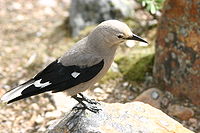- Nutcracker (bird)
-
Nutcrackers 
Nucifraga columbiana Scientific classification Kingdom: Animalia Phylum: Chordata Class: Aves Order: Passeriformes Family: Corvidae Genus: Nucifraga
Brisson, 1760Species The nutcrackers (Nucifraga) are a genus of two species of passerine bird, in the family Corvidae, related to the jays and crows. One, the Spotted Nutcracker (Nucifraga caryocatactes), occurs in Europe and Asia, the other, Clark's Nutcracker (Nucifraga columbiana), in western North America.
The most important food resources for both these species are the seeds (pine nuts) of various Pines (Pinus sp.), principally the cold-climate (far northern or high altitude) species of white pine (Pinus subgenus Strobus) with large seeds: P. albicaulis, P. armandii, P. cembra, P. flexilis, P. koraiensis, P. parviflora, P. peuce, P. pumila, P. sibirica and P. wallichiana, and also the pinyon and lacebark pines in subgenus Ducampopinus. In some regions, where none of these pines occur, the seeds of Spruce (Picea sp.) and hazelnuts (Corylus sp.) form an important part of the diet too. The bills of these birds are specialized tools for extracting seeds from pine cones.
Surplus seed is always stored for later use, and it is this genus that is responsible for the re-establishment of their favoured pines over large areas either burnt in forest fires or cleared by man. The Nutcracker can store as many as 300,000 pine nuts in a single season, remembering the location of as many as 80% of their stash, even when buried in snow.[citation needed]
Various insects are also taken, including bee and wasp larvae, and also birds' eggs and nestlings, and carrion if it is found.
Nesting is always early in this genus, so as to make the best use of pine nuts stored the previous autumn. The nest is usually built high in a conifer. There are normally 2-4 eggs laid and incubated for 18 days. Both sexes feed the young which are usually fledged by about 23 days and stay with their parents for many months, following them to learn food storage techniques.
Neither species is migratory, but they will leave their usual ranges if a cone crop failure causes a food shortage.
References
- Lanner, R. M. (1996). Made for each other: a symbiosis of birds and pines. OUP ISBN 0-19-508903-0
External links
- Nutcracker videos on the Internet Bird Collection
Extant species of family Corvidae Kingdom: Animalia · Phylum: Chordata · Class: Aves · Subclass: Neornithes · Superorder: Neognathae · Order: PasseriformesFamily Corvidae Choughs Treepies PlatysmurusTemnurusOriental
magpiesOld World jays PtilostomusStresemann's
BushcrowZavattariornis
Categories:- Nucifraga
- Genera of birds
Wikimedia Foundation. 2010.
Look at other dictionaries:
Nutcracker (disambiguation) — A nutcracker is a tool for cracking nuts. Nutcracker or The Nutcracker may also refer to: The Nutcracker and the Mouse King, a story by E.T.A. Hoffmann The Nutcracker (Histoire d un casse noisette, 1844): a revision by Alexandre Dumas, père The… … Wikipedia
Bird College — of Dance, Music Theatre Performance Established 1945 Type Independent FE HE College … Wikipedia
Nutcracker — Nut crack er, n. 1. An instrument for cracking nuts. [1913 Webster] 2. (Zo[ o]l.) (a) A European bird ({Nucifraga caryocatactes}), allied to the magpie and crow. Its color is dark brown, spotted with white. It feeds on nuts, seeds, and insects.… … The Collaborative International Dictionary of English
nutcracker — [nut′krak΄ər] n. 1. an instrument for cracking the shells of nuts, usually consisting of two hinged metal levers, between which the nut is squeezed 2. either of two jaylike corvid birds that feed on nuts; specif., a white spotted, dark brown… … English World dictionary
Nutcracker — This article is about the mechanical device. For the ballet, see The Nutcracker. For other uses, see Nutcracker (disambiguation). A nutcracker with a functional design A nutcracker is a mechanical device for cracking nuts. Usually they work on… … Wikipedia
nutcracker — /nut krak euhr/, n. 1. an instrument or device for cracking the shells of nuts. 2. any of several corvine birds of the genus Nucifraga that feed on nuts, as the common nutcracker, N. caryocatactes, of Europe and Clark s nutcracker, N. columbiana … Universalium
nutcracker — n. instrument used to crack nutshells; type of bird related to the crow that eats nuts and seeds of the pine tree … English contemporary dictionary
nutcracker — noun 1》 (nutcrackers) a device for cracking nuts. 2》 a bird of the crow family that feeds on the seeds of conifers. [Genus Nucifraga: two species.] … English new terms dictionary
Clark's Nutcracker — Nucifraga columbiana Clark s Nutcracker Conservation status Least Conce … Wikipedia
Spotted Nutcracker — Conservation status Least Concern … Wikipedia
